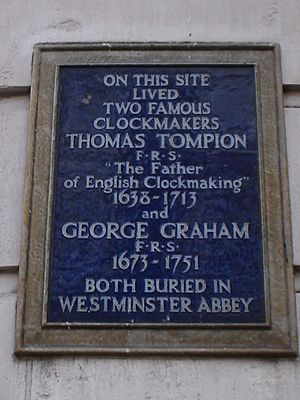George Graham (clockmaker) facts for kids
George Graham (born July 7, 1673, died November 16, 1751) was an English clockmaker, inventor, and scientist who studied the Earth's magnetic field. He was also a member of the Royal Society, a famous group of scientists.
George Graham was born in Kirklinton, a place in England. Like his teacher, Thomas Tompion, George was a Quaker, a member of the Religious Society of Friends. In 1688, he moved from Cumberland to London to work with Tompion. Later, George married Tompion's niece, Elizabeth Tompion.
Contents
Graham's Amazing Career
George Graham worked closely with the important English clockmaker Thomas Tompion during Tompion's last years. Graham made many improvements to pendulum clocks. He invented the mercury pendulum, which helped clocks keep time better. He also invented the orrery, a mechanical model that shows how planets move around the Sun. In 1722, he became the Master of the Worshipful Company of Clockmakers, a top position for clockmakers.
From 1730 to 1738, Graham taught Thomas Mudge, who later became a very famous watchmaker himself. Mudge invented the lever escapement, an important part for pocket watches.
Graham knew a lot about astronomy, which is the study of stars and planets. He invented many useful tools for astronomers and made others better. For example, he built a large wall-mounted telescope for Edmond Halley at the Greenwich Observatory. He also made a special telescope and a tool to measure stars directly overhead for James Bradley, which helped Bradley make new discoveries.
Graham also helped French scientists by building equipment they used to measure the Earth. He created the most detailed planetarium known at that time. This model showed the movements of planets and other space objects very accurately. It was made for Charles Boyle, 4th Earl of Orrery.
George Graham met John Harrison when Harrison first came to London. Graham became a long-time helper and supporter of Harrison's work. Harrison was trying to build a very accurate clock for ships, called a marine chronometer. Graham and Harrison spent many hours talking about clocks. Graham even gave Harrison money without interest to help him continue his work. Later, Graham introduced Harrison to the Board of Longitude and helped him get more money for his project.
Understanding the Deadbeat Escapement
The deadbeat escapement is a special part inside a clock that helps it keep very accurate time. Many people mistakenly think George Graham invented it around 1715. However, it was actually invented earlier, around 1675, by an astronomer named Richard Towneley. Graham's teacher, Thomas Tompion, was the first to use it in some of his clocks. These included two very precise clocks made for the new Greenwich Observatory in 1676.
Graham's Key Achievements
One of George Graham's biggest contributions to science was discovering that the Earth's magnetic field changes slightly each day. This was in 1722 and 1723. He was also one of the first to notice that the direction a compass needle points changes slowly over many years. The compasses he made were used by many scientists who studied magnetism. Around 1730, George loaned about £200 to John Harrison. This money helped Harrison start building his famous marine timekeeper, later known as H1. George Graham was often called 'Honest George Graham' by others in his trade.
Examples of His Work
- A tall clock that runs for 28 days with a deadbeat escapement, made around 1745. You can see it at Moyse's Hall Museum in Bury St Edmunds, UK.
His Final Years
George Graham passed away at his home in Fleet Street, London. He was buried in the same tomb as his friend and teacher, Thomas Tompion, in Westminster Abbey.
In Popular Media
The actor Peter Vaughan played George Graham in the TV show Longitude in the year 2000.
See also
 In Spanish: George Graham (relojero) para niños
In Spanish: George Graham (relojero) para niños



